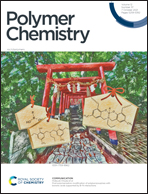Synthesis of a bead-like multicyclic polymer by UV-induced coupling of an anthracene-telechelic monocyclic precursor and its reversible topological conversion†
Abstract
In this study, a bead-like multicyclic polymer was synthesized by the UV-induced coupling reaction of an anthracene-telechelic monocyclic precursor and the reversible topological transformation between the monocyclic polymer and the multicyclic polymer was realized. Poly(ethylene oxide) (PEO) containing bromine and anthryl groups at both ends was used as a macroinitiator for the atom transfer radical polymerization (ATRP) of styrene to afford a linear block polymer (PS-PEO-Br). After azidation, the azide-terminated linear polymer (PEO-PS-N3) underwent bimolecular ring-closure using sym-dibenzo-1,5-cyclooctadiene-3,7-diyne (DIBOD) as a bifunctional linker via a self-accelerating click reaction, and the corresponding monocyclic polymer with two pendant anthryl groups (C(PEO-PS)-ant) was synthesized. Considering the photo-responsive nature of anthracene, the monocyclic polymer was taken as a macromonomer for synthesizing a bead-like multicyclic polymer through the dimerization reaction of anthryl groups under 365 nm UV irradiation. The obtained polymers were characterized by NMR, FT-IR and GPC. According to the result of GPC, there were about 14 “monocyclic units” in the bead-like multicyclic polymer on average. Moreover, the bead-like multicyclic polymer could be cleaved at the nodal points and converted back to the monocyclic structure when exposed to 254 nm UV light.



 Please wait while we load your content...
Please wait while we load your content...